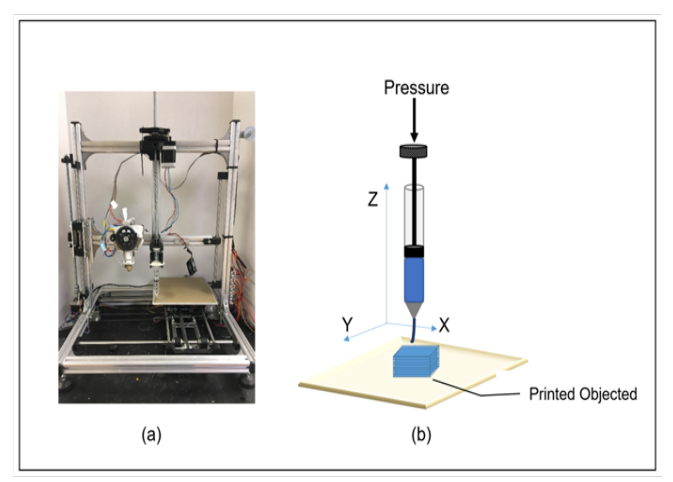3D Printability of Gelatin/Alginate Hydrogels & Post Processing with Calcium Chloride
Researchers from Iowa State University are examining detailed processes in bioprinting, outlining their findings in the recently published ‘Printability of Hydrogel Composites Using Extrusion-Based 3D Printing and Post-Processing with Calcium Chloride.’ In this study, the authors analyze the further potential of gelatin-alginate hydrogels in 3D printing, combining post-processing with a calcium chloride solution to smooth part surfaces and increase gel strength.
While 3D printing and additive manufacturing processes are making significant impacts in a wide range of industries today, many expect this technology to open new doors for the manufacturing of pills and creating innovative forms of drug delivery systems. The benefits are undeniable, offering manufacturers the ability to continue promoting patient-specific treatment in the form of medications customized to each patient in terms of dose, structure, and more.
Alginate, a polysaccharide found in the cell walls of brown algae, has been highlighted in numerous studies related to 3D printing previously as researchers have combined the versatile material with cellulose nanocrystals, graphene oxide, and other alternative systems for fabrication. In demand because of its hydrophilic properties, alginate is also biocompatible, making it useful for researchers in bioprinting today. And while gelatin may not be as useful on its own in 3D printing applications, when combined with hydrogel composites, the two materials enhance one another in terms of viscosity, elasticity, and thermal qualities.
During the study, experimental hydrogels were created with three different ratios (1:4, 1:1 and 4:1 (w/w)) of gelatin and alginate powder.
“To determine the printability of material, two rheology tests were conducted. The flow ramp test was carried out to evaluate the apparent viscosity under an increasing shear rate ranging from 0.1 to 30.0 1/s. In order to characterize the dynamic modulus of a material, the oscillation frequency sweep test was conducted under a small strain of 0.1 with increased frequency from 0.1 to 1000 rad/s throughout the test,” explained the researchers.
Samples for the study were printed on a Velleman K8200 3D printer, after giving polymers a full day of hydration time. Each object consisted of 12 layers, printed with a syringe and nozzle diameter of 0.636mm.
“This shear-thinning behavior suggested that when there is shear stress during the 3D printing process, the material would flow easier with reduced viscosity,” explained the researchers. “This is probably due to the network of molecules were disrupted under shear stress. Due to this property, these materials are 3D printable through the extrusion-based printer once the stress higher than the yield stress is applied.”
The authors do not recommend the use of gelatin or alginate alone, however, as gelatin is too brittle, and alginate is too fluid to sustain a stable structure on its own.

Representative images of the 3D printed geometries fabricated with 5% solid containing gelatin-alginate hydrogels with different gelatin and alginate ratios (G/A): 1:4, 1:1, and 4:1. The images on column (a) showed the objects that were 3D printed with only gelatin-alginate hydrogels in a cuboid-shaped. The images aligned with column (b) showed the 3D printed objects after post-processing by applying 0.1M of CaCl2 solution on top of the surface with dropper.

Representative images of the 3D printed structures after soaking into 0.1M of calcium chloride (CaCl2) with different soaking times of 10, 20, 30 and 60 minutes
The surface smoothness of the composites showed significant improvement upon immersion in the CaCl2 solution.
“Based on the rheological properties and the 3D printing results, we can conclude that the optimal ratio for the gelatin and alginate is 1:1. In addition, the post-processing treatment with different soaking time in calcium chloride solution indicated that longer soaking time would result in a stronger gel; however, further tests should be done to determine the effects of soaking time on gel strength,” concluded the researchers. “The most important finding of this study is that the gel strength and surface smoothness can be significantly improved by soaking the 3D printed geometries in the calcium chloride solution. The problem to address in the next step is to improve shape retention during the post-processing.”
What do you think of this news? Let us know your thoughts! Join the discussion of this and other 3D printing topics at 3DPrintBoard.com.
[Source / Images: ‘Printability of Hydrogel Composites Using Extrusion-Based 3D Printing and Post-Processing with Calcium Chloride’]Subscribe to Our Email Newsletter
Stay up-to-date on all the latest news from the 3D printing industry and receive information and offers from third party vendors.
Print Services
You May Also Like
New Business: Temporary, Migratory, & Modular 3D Printed Architecture
If we look at potentially emerging 3D printing businesses, then architecture has not been fully explored. Yes, there is a lot of house 3D printing going on worldwide. From deployable...
3D Printing News Briefs, April 19, 2025: Material Extrusion Standard, Metal Powder, & More
In today’s 3D Printing News Briefs, we’re covering a proposed standard for material extrusion, before moving on to business and metal powder. We’ll end with a commercial store’s robotic 3D...
Japan Unveils World’s First 3D Printed Train Station
Japan is now home to what we believe is the world’s first train station built with 3D printing technology. Located in Arida City, just south of Osaka, the new Hatsushima...
restor3d Raises $38M to Expand 3D Printed Orthopedic Implants
Backed by $38 million in new funding, restor3d is pushing ahead with the launch of four personalized implant lines, set to roll out in 2025 and 2026. This latest venture...



























